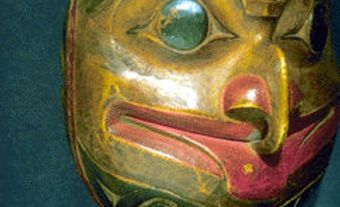Ts’msyen (Tsim-she-yan, meaning “Inside the Skeena River”; sometime spelled Tsimshian or Tsm’syen) is a name that is often broadly applied to Indigenous peoples of the Pacific Northwest Coast. They speak languages of the Ts’msyen language family. In the 2016 census, 2,695 people reported speaking a Ts’msyen language. The largest concentration of Ts’msyen speakers (98.1 per cent) live in British Columbia. In the 2016 census, 5,910 people claimed Ts’msyen ancestry.
Population and Territory
Ts’msyen communities are found in Terrace and Prince Rupert, British Columbia, and in southern Alaska. Archaeological excavations in the harbour at Prince Rupert have unearthed the remains of cedar plank house villages that date back 5,000 years. As such, the Ts’msyen claim one of the oldest continuous cultural heritages in the Americas. (See also Architectural History of Indigenous Peoples in Canada.) Ts’msyen peoples are also generally held to be related historically to the Penutian peoples of Oregon and California.
(courtesy Native Land Digital / Native-Land.ca)
Society and Culture
The Ts’msyen, along with the Tlingit of Alaska, British Columbia and the Yukon and the Haida of Haida Gwaii, represent the Northwest Coast cultural area. This cultural area is characterized by carvings, such as totem poles and traditional ceremonies, including the potlatch. Taking pride in their heritage, the Ts’msyen continue to practice certain cultural customs. These include hosting community ceremonial feasts to celebrate name giving, marriage, divorce, adoption and funerals. Few Ts’msyen continue the traditional practice of trapping for a living. However, fishing remains an important part of their economy.
Ts’msyen society was originally matrilineal. Descent was traced through the female line. Ts’msyen society was also based on a moiety (clan system). Each Ts’msyen recognizes himself/herself as belonging to one of four phratries (tribes or totems). These phratries are Frog or Raven, Wolf, Eagle, and Killer Whale or Fireweed. Ts’msyen individuals belong to the same phratry as their mother. Traditionally, they married someone from a different phratry than their own. Hereditary, chiefly titles are still maintained by both men and women for ceremonial purposes.
Language
The Ts’msyen language can be grouped into four dialects. Northern Ts’msyen is found along the lower Skeena River. Nisga'a is found along the Nass River. Gitxsan is from the upper Skeena River. Southern or Coast Ts’msyen is found south of the Skeena River to the coast. Southern or Coast Ts’msyen is sometimes referred to as Ts’msyen Proper. They included groups along the lower Skeena River from the Kitselas Canyon and Kitsumkalum (near Terrace). They also included communities along the adjacent coast south to Milbanke Sound. This includes Port Simpson, Metlakatla (in the Prince Rupert area), Kitkatla, Hartley Bay and Kitasu Bay. According to Statistics Canada, 250 people identified Ts’msyen as their mother tongue. Another 455 specified the Nisga’a language as their mother tongue. Additionally, 1,000 people listed the Gitxsan language as their mother tongue. (See also Indigenous Languages in Canada.)
Colonial History
In 1862, Anglican Missionary William Duncan established the Christian settlement of Metlakatla in British Columbia. (See also Missions and Missionaries.) Approximately 350 Ts’msyen people from Port Simpson joined Duncan in Metlakatla. In 1887, Duncan and about 825 Metlakatla Ts’msyen founded the new community of “New” Metlakatla, near Ketchikan, Alaska.
Europeans increasingly encroached on Ts’msyen territories. The Ts’msyen found themselves forced onto smaller parcels of land (See also Indigenous Territory). As a means of assimilating Indigenous populations, the Canadian government sent Ts’msyen children to residential schools. There, they and other Indigenous children were forbidden from speaking their languages and practicing their cultures. Officially launched in 2008, the Truth and Reconciliation Commission of Canada (TRC) sought to guide Canadians through the difficult discovery of the facts behind the residential school system. It sought to lay the foundation for lasting reconciliation across Canada.
Treaty Negotiations
In 1988, the Ts’msyen created the Tsimshian Tribal Council. It represented seven Ts’msyen bands in negotiations with the British Columbia and federal governments. These bands included Kitselas, Kitsumkalum, Gitga’at, Kitasoo, Metlakatla, Lax Kw’alaams and Gitxa’ala. (See also Indigenous Land Claims.) In 1991, the council officially entered the British Columbia treaty process. Negotiations stalled during the negotiation of the agreement-in-principle. In 1997, a framework for a comprehensive treaty agreement was established. It included the original seven bands and the Government of British Columbia.
In 2004 a new negotiating council — the Tsimshian First Nations Treaty Society (TFN) — replaced the Tsimshian Tribal Council. It represented five of the seven original members in the British Columbia treaty process. These five members were the Gitga'at Nation, Kitasoo/Xai'xais Band, Kitselas Band, Kitsumkalum Band and the Metlakatla First Nation. The TFN continues to work towards self-government and the protection of territorial, economic and political rights.

 Share on Facebook
Share on Facebook Share on X
Share on X Share by Email
Share by Email Share on Google Classroom
Share on Google Classroom








